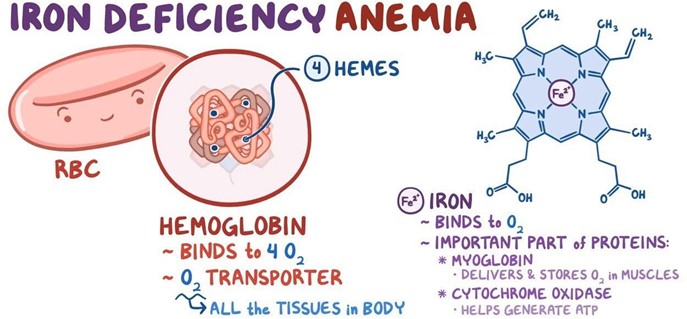A nurse in a pediatric clinic is caring for a child who has iron deficiency anemia and a new prescription for ferrous sulfate tablets. Which of the following instructions should the nurse provide the parents regarding the administration of this medication?
Iron (Ferrous Sulfate) may turn stools tarry green.
Administer at bedtime.
Give with a 240 mL (8 oz) glass of milk.
Administer at mealtimes.
The Correct Answer is A
Choice A: This instruction is correct, as iron supplements can cause a change in the color and consistency of stools, making them dark, green, or black. This is not a sign of bleeding or infection, but a normal side effect of iron therapy. The parents should be informed of this possibility and reassured that it is harmless.
Choice B: This instruction is incorrect, as iron supplements should not be administered at bedtime, but rather one hour before or two hours after meals. This is because iron absorption is reduced by food, especially dairy products, antacids, or calcium supplements. The parents should be instructed to give the medication on an empty stomach or with a small amount of food if it causes nausea.
Choice C: This instruction is incorrect, as iron supplements should not be given with milk, as milk contains calcium, which can interfere with iron absorption and reduce its effectiveness. The parents should be instructed to avoid giving milk or other dairy products within two hours of the medication.
Choice D: This instruction is incorrect, as iron supplements should not be administered at mealtimes, but rather one hour before or two hours after meals. This is because iron absorption is reduced by food, especially dairy products, antacids, or calcium supplements. The parents should be instructed to give the medication on an empty stomach or with a small amount of food if it causes nausea.

Nursing Test Bank
Naxlex Comprehensive Predictor Exams
Related Questions
Correct Answer is B
Explanation
Choice A: This instruction is not correct, as the child should avoid taking a tub bath for the first 3 days after a cardiac catheterization, which is a procedure that involves inserting a thin tube into a blood vessel and advancing it to the heart to diagnose or treat heart problems. Taking a tub bath can increase the risk of infection or bleeding at the insertion site, which is usually in the groin or arm. The child should take a shower instead and keep the insertion site clean and dry.
Choice B: This instruction is correct, as the child may experience some discomfort or soreness at the insertion site after a cardiac catheterization. Giving the child acetaminophen can help relieve the pain and reduce inflammation. The child should avoid taking aspirin or ibuprofen, as they can increase the risk of bleeding.
Choice C: This instruction is not correct, as the child does not need to stay home for 1 week after a cardiac catheterization unless there are complications or specific instructions from the provider. The child can resume normal activities within 2 to 3 days after the procedure, as long as they avoid strenuous exercise, heavy lifting, or contact sports.
Choice D: This instruction is not correct, as the child does not need to limit their diet to clear liquids for the first 24 hours after a cardiac catheterization unless there are complications or specific instructions from the provider. The child can resume their regular diet as soon as they feel hungry and drink plenty of fluids to flush out the contrast dye used during the procedure.

Correct Answer is C
Explanation
Choice A reason: This choice is incorrect because the loss of a parent is not the priority risk factor for suicide completion. Loss of a parent is a stressful life event that may cause grief, depression, or anxiety in an adolescent, but it does not necessarily increase the risk of suicide completion. However, the loss of a parent may be associated with other risk factors such as low self-esteem, poor coping skills, or social isolation, which can contribute to suicidal ideation or behavior.
Choice B reason: This choice is incorrect because a history of substance abuse is not the priority risk factor for suicide completion. History of substance abuse is a behavioral problem that may impair the judgment, mood, or impulse control of an adolescent, but it does not necessarily increase the risk of suicide completion. However, a history of substance abuse may be associated with other risk factors such as mental illness, family conflict, or legal trouble, which can contribute to suicidal ideation or behavior.
Choice C reason: This choice is correct because a previous suicide attempt is the priority risk factor for suicide completion. Previous suicide attempt is a clear indicator of suicidal intent and capability, and it increases the likelihood of future attempts and completion. According to the American Foundation for Suicide Prevention (AFSP), about 40% of people who die by suicide have a history of previous attempts. Therefore, assessing and addressing previous suicide attempts is essential to prevent further harm and save lives.
Choice D reason: This choice is incorrect because active psychiatric disorder is not the priority risk factor for suicide completion. Active psychiatric disorder is a mental health condition that may affect the thoughts, feelings, or behaviors of an adolescent, but it does not necessarily increase the risk of suicide completion. However, active psychiatric disorder may be associated with other risk factors such as hopelessness, helplessness, or isolation, which can contribute to suicidal ideation or behavior.

Whether you are a student looking to ace your exams or a practicing nurse seeking to enhance your expertise , our nursing education contents will empower you with the confidence and competence to make a difference in the lives of patients and become a respected leader in the healthcare field.
Visit Naxlex, invest in your future and unlock endless possibilities with our unparalleled nursing education contents today
Report Wrong Answer on the Current Question
Do you disagree with the answer? If yes, what is your expected answer? Explain.
Kindly be descriptive with the issue you are facing.
